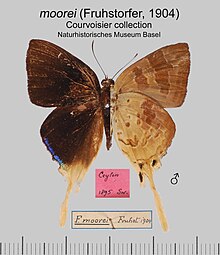Bindahara phocides, the plane,[1][2] is a small butterfly found Indomalayan (including Sri Lanka, India)[1] and Australasian realms that belongs to the lycaenids or blues family.[1][2][3]
| Plane | |
|---|---|

| |
| Bindahara phocides isabella Indonesia | |

| |
| Bindahara phocides moorei Ceylon Courvoisier Collection, Basel | |
| Scientific classification | |
| Domain: | Eukaryota |
| Kingdom: | Animalia |
| Phylum: | Arthropoda |
| Class: | Insecta |
| Order: | Lepidoptera |
| Family: | Lycaenidae |
| Genus: | Bindahara |
| Species: | B. phocides
|
| Binomial name | |
| Bindahara phocides (Fabricius 1793)
| |
Description
editMale. Upperside dark fuliginous-brown. Forewing without markings. lllndwing with the tail, anal lobe, and a small anal patch dull ochreous; a small indistinct spot on the anal lobe. Underside pale ochreous-brown. Forewing, a black spot at the base of the cell, a dark brown, broad, outwardly curved band with irregular ochreous edges, from the costal nervure to a little below the median vein, crossing the cell somewhat beyond its middle, with pale indications of its continuation hindwards, a pale brown line, edged on both sides with ochreous at the end of the cell; a dark brown, broad discal band, from the costa to a little below the sub-median vein, composed of conjoined squarish spots, the first four outwardly oblique, the others commencing a little inwards nearly straight down the wing, narrowing gradually hindwards; indications of a pale brown, sub-marginal, double series of lunular marks. Hindwing with a basal blackish-brown spot, a larger one immediately below the costal vein, two smaller ones in a line below it, two conjoined spots closing the cell, a discal very irregular band, commencing from the costal vein where there is a large square blackish-brown spot attached to it below, half outwards is a similar spot, with a smaller blackish-brown spot attached to its lower side half outwards; these are followed by a curiously formed series of five small paler spots, the first well outside, a parallel pair below it and another similar pair below and inwards; then there is an indistinct pair below these joined on the inner side to a heart-shaped pale spot with brown edges, with a curving sinuous brown line attached, which bends inwards and upwards near the abdominal margin at its middle and runs up it to the base in a series of indistinct spots, all edged with ochreous; a sub-terminal series of lunules enclosing two blackish spots with scattered metallic greenish scales and a prominent black spot on the anal lobe, all of which vary much in different examples, and are sometimes obscure. Antennse black, paler on the underside, with white dots; head and body above and below concolorous with the wings. Female. Upperside brown, with a bronzy gloss in certain lights, a pure white patch divided by the brown veins, on the lower end of the hindwing, margined outwardly with a blackish anteciliary line, containing a large black round spot at the base of the tail on the outer side and another smaller and less distinct spot on the inner side, a black spot on the anal lobe. Underside white, bauds and spots paler than in the male, but similarly disposed.
Subspecies
editThe subspecies are:[2]
- B. p. phocides Sikkim - Myanmar, South Yunnan
- B. p. fumata (Röber, 1887) Sulawesi, Talaud, Banggai, Sula
- B. p. moorei Fruhstorfer, 1904 Sri Lanka, south India[1]
- "Male and female, similar to the nominate subspecies above and below in both sexes, except that on the upperside of the hindwing there is a narrow, terminal blue-green band from near the apex to vein 2."[3]
- B. p. phocas Staudinger, 1889 Palawan
- B. p. chromis (Mathew, 1887) Bismarck Archipelago, Solomons
- B. p. isabella (Felder, 1860) Cape York - Townsvill
- B. p. origenes Fruhstorfer, 1912 Philippines (Mindanao)
Biology
editThe larva feeds on Salacia.
Gallery
edit-
At Mount Harriet National Park in the Andamans
-
B. p. moorei
See also
editReferences
edit- ^ a b c d R.K., Varshney; Smetacek, Peter (2015). A Synoptic Catalogue of the Butterflies of India. New Delhi: Butterfly Research Centre, Bhimtal & Indinov Publishing, New Delhi. doi:10.13140/RG.2.1.3966.2164. ISBN 978-81-929826-4-9.
- ^ a b c Savela, Markku. "Bindahara phocides (Fabricius, 1793)". Lepidoptera and Some Other Life Forms. Retrieved June 30, 2018.
- ^ a b c One or more of the preceding sentences incorporates text from this source, which is in the public domain: Swinhoe, Charles (1911–1912). Lepidoptera Indica. Vol. IX. London: Lovell Reeve and Co. pp. 24–26.
- Evans, W.H. (1932). The Identification of Indian Butterflies (2nd ed.). Mumbai, India: Bombay Natural History Society.
- Gaonkar, Harish (1996). Butterflies of the Western Ghats, India (including Sri Lanka) - A Biodiversity Assessment of a Threatened Mountain System. Bangalore, India: Centre for Ecological Sciences.
- Gay, Thomas; Kehimkar, Isaac David; Punetha, Jagdish Chandra (1992). Common Butterflies of India. Nature Guides. Bombay, India: World Wide Fund for Nature-India by Oxford University Press. ISBN 978-0195631647.
- Haribal, Meena (1992). The Butterflies of Sikkim Himalaya and Their Natural History. Gangtok, Sikkim, India: Sikkim Nature Conservation Foundation.
- Kunte, Krushnamegh (2000). Butterflies of Peninsular India. India, A Lifescape. Hyderabad, India: Universities Press. ISBN 978-8173713545.
- Wynter-Blyth, Mark Alexander (1957). Butterflies of the Indian Region. Bombay, India: Bombay Natural History Society. ISBN 978-8170192329.